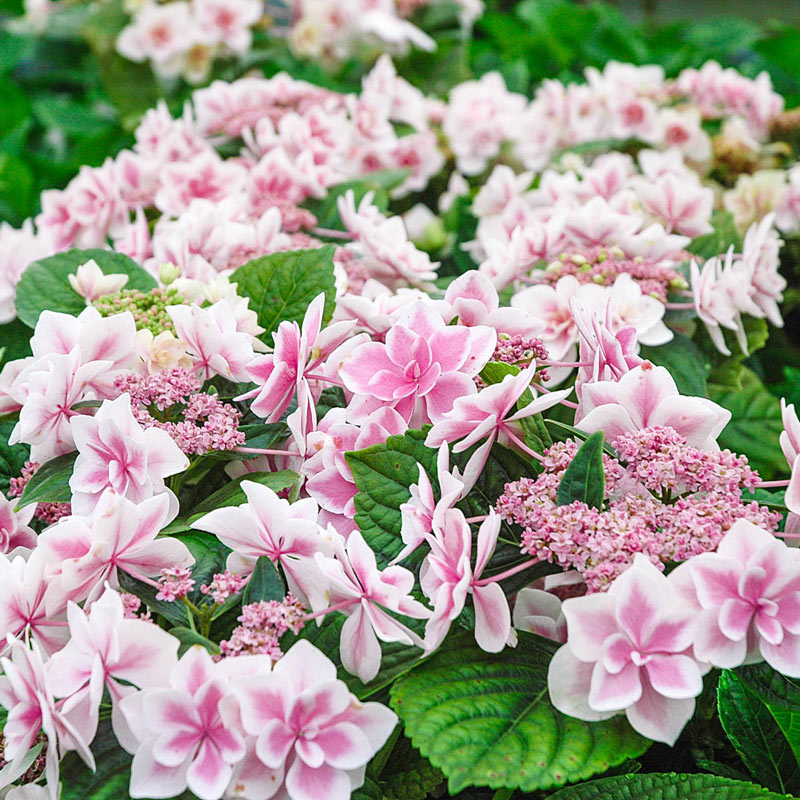
Mountain: (Hydrangea serrata) More compact than Mopheads and presenting dainty lacecap blooms and smaller leaves, these hydrangeas are native to the mountains of Korea and Japan where they're known as 'Tea of Heaven'. Smooth/ Snowball: (Hydrangea arborescens) Also known as "Wild" Hydrangeas, these shrubs are native to the eastern US - and while their color cannot be altered by changing soil pH, their blooms tend to turn a pale green as fall approaches. Their arching branches and plentiful blooms also tolerate more sun than other varieties. Panicle: (Hydrangea paniculata) Huge, cone-shaped blooms and excellent cold hardiness are the hallmarks of the Panicle hydrangea. Also known as "Bigleaf" hydrangeas, the foliage on Mopheads is quite enormous and delivers a lot of greenery to the garden. Mopheads: (Hydrangea macrophylla) The most well-known (yet least cold hardy) hydrangea, Mopheads are known for their oversized blooms that come in two flower types - Lacecaps and Pom-poms. For example, you can find Mopheads that bloom on new growth and Panicles that are container-friendly. Many hydrangeas today are available in a range of heights and bloom cycles, regardless of their overall type. It is, however, more difficult to turn hydrangea blooms pink because as a general rule, most plants struggle to be healthy in soils with a pH above 7. This can be achieved by adding lime around your planting area. The more alakaline (or sweet) your soil is, the deeper pink your blooms will be. To coax your hydrangeas into producing blue blooms, you can amend your soil with sulfur, or mulch your plants with a pine and/or cedar needle mulch.Īlkaline soils (with a pH above 7) produce pink blooms. The color of native Smooth hydrangeas (Hydrangea arborescens) cannot be changed.Īcid soils (with a pH below 7) produce purple-to-blue blooms, with the brightest blue blooms resulting from the most-acidic soils. Although soil pH can be changed directly in the garden bed, it often takes more than one season to see results. To really see bold colors, you'll have the best results when planting in containers, which will allow you to create your preferred soil conditions at planting time. The color of most hydrangea blooms are directly tied to the mineral make up of your soil and its overall pH. What does "Bloom color depends on soil type" mean? A simple task for sure, but one that needs to be remembered. Likewise, warm-climate gardeners who choose varieties that only bloom on new wood, will have to make it a point to prune their hydrangea shrubs in order to encourage new buds to form. Choosing a variety that blooms on new wood (or both types of growth) is extra insurance it means that regardless of your winter and late-spring weather, you can still count on your shrub to produce flowers come summer. This detail is especially valuable for cold-climate gardeners who may be apt to lose some of their hydrangea branches to breakage from heavy snow and ice, or who may see developing buds killed off by late spring frosts.įor these gardeners, losing old growth branches and young buds could mean missing out on hydrangea flowers the following summer. Some hydrangeas produce buds that will turn into flowers on old wood (also called "last year's growth"), while others produce blooms on new wood (aka "this year's growth") and still others will flower on both old and new wood. What does "Blooms on old/new wood" mean and what does that have to do with winter? There are many varieties available, each showcasing differing bloom colors, flower shapes, overall heights/spreads, levels of winter hardiness, and abilities to be grown in containers.

Hydrangea shrubs are native to the US and Asia and produce showy flowers throughout the summer season. Plants require a shady location and adequate moisture.

This deciduous shrub is long-lived and easy to grow, tolerating a range of soil and climate conditions. Fast-growing with glossy green foliage and a rounded habit, Double Delights® 'Star Gazer' Hydrangea shines in patio containers or massed in the shrub border.

With a mildly-sweet fragrance, ‘Star Gazer’ delights gardeners and attracts butterflies to the garden. The fully double blooms are held upright atop extra strong stems perfect for cutting. New growth produces fresh flowers in mid summer and will continue to produce blossoms through autumn if spent flowers are deadheaded regularly. A first flush of blooms emerges on old wood in early summer. As the name suggests, ‘Double Delights® 'Star Gazer' Hydrangea blooms twice each summer.


 0 kommentar(er)
0 kommentar(er)
